How the 1960s sold holidays to consumers
Advertisers were lured to the pages of The Australian by an audience that was increasingly mobile, in the literal and financial sense.
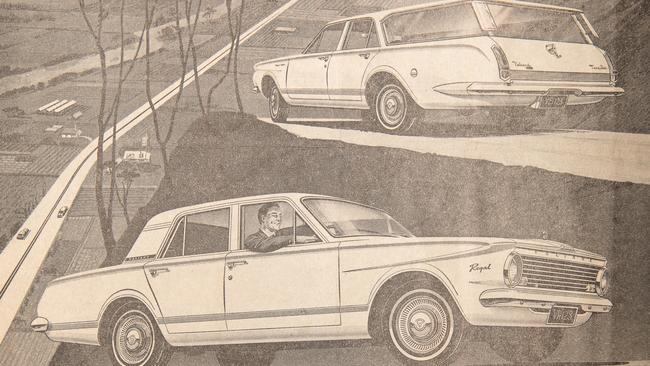
When The Australian first rolled off the presses in July 1964, the nation’s population was 11.3 million, about 100,000 of whom were buying the broadsheet daily within four years. Often bought as a second newspaper by readers with a keen interest in national affairs and business, it identified growth sectors of the second half of the 20th century (and devoted sections to them), including computers, higher education and aviation. But The Australian reader was also judged to be interested in the finer aspects of life – the arts and literature, fashion and, naturally, travel (the first features were badged Going Places). Advertisers were keen to woo this mobile (in the literal sense and also upwardly) audience, and this is how they went about it in the early days.
A word of caution before going ga-ga over the prices. According to Reserve Bank figures, the minimum weekly wage in 1964 was $37.70 for men and $27.10 for women. The average weekly earning for males was just under $50, with higher earners hoping for about $70, which equates to a buying power of about $1200 today. The prices in some ads are in pounds, others in dollars. Australia was in training for the introduction of decimal currency (two dollars to a pound) on February 14, 1966. The first copies of The Australian sold for fourpence in Canberra and sixpence elsewhere.
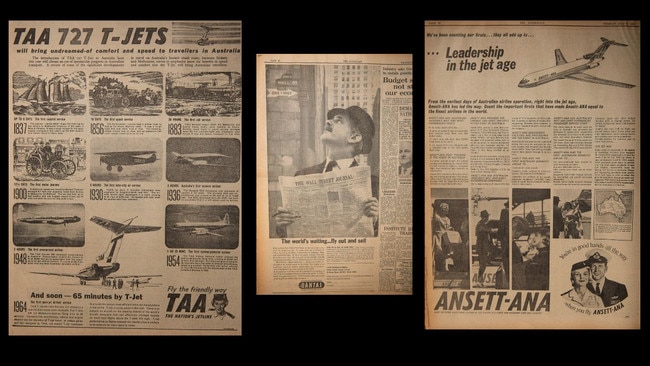
July 20, 1964 – July 21, 1964
With not a glimmer of daylight between them thanks to the two-airlines policy (enforcing the same planes, timetables and fares), the government-owned TAA and private Ansett-ANA had to dream up points of difference when the Boeing 727 joined their fleets on the same day, October 16, 1964. For TAA, which branded its newcomers Whispering T-Jets, customers would be flying the friendly way, in speed and comfort. Ansett customers were “in good hands – all the way” and would benefit from the company’s leadership into the jet age. What a choice.
July 15, 1964
The national airline, Qantas, was an early adopter of The Australian as an advertising vehicle, targeting its business readership. In an ad featuring a dapper fellow looking more at home in the City of London, Qantas zeroed in on New York among global destinations as a place for Aussies to spread their wings and sell their wares. A tax concession of up to 80 per cent off airfares was an attractive incentive for eager exporters.
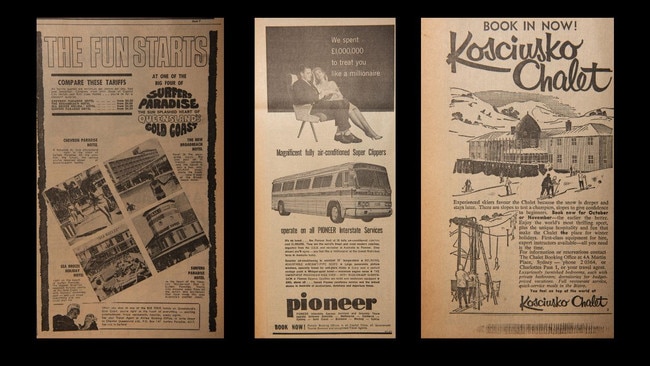
May 28, 1968
The Gold Coast was gaining a reputation as a glam destination by the 1960s. Until the 50s, the stretch of squeaky-white beaches and settlements from Southport to Coolangatta had simply been the South Coast but the highway was being dotted by motels, the survivors now prized as retro gems. Surfers Paradise, so named in a marketing masterstroke in 1933, was the sophisticated hub, with the first high-rise, Kinkabool, reaching skywards in 1960 and meter maids in bikinis and high heels parading the streets. Attending poolside pyjama parties at the Beachcomber Hotel, on T+L’s cover, was a one-way ticket to notoriety in the Sunday newspapers.
July 24, 1964
Cobb & Co (founded by American Freeman Cobb) gave Australian coach travel a romantic boost in the 1850s, servicing goldfields and the outback, carrying the mail and thwarting bushrangers. It seemed the way to go in a nation with vast distances and a rail network beset by state stupidities and varying gauges. By the 1960s, when flying was a rather exclusive affair, coach companies such as Ansett Pioneer were covering the continent (at least from Adelaide in the south to Cairns in the north) and upping the stakes in luxury on wheels. Its Super Clipper fleet, imported from the US, promised the world, even toilets on board. Now to get some shut-eye with a pillow propped against the window under a chilly aircon vent.
July 16, 1964
It’s odd that the nation’s highest peak, Mt Kosciuszko (the “z” was officially added in 1997), was named after a Polish patriot who never came near Australia, but we have mountaineer Paul Edmund de Strzelecki to thank for that. While hardy enthusiasts had been skiing in suitable terrain in Tasmania, Victoria and NSW since the late 19th and early 20th centuries, the winter sport was boosted by the post-war arrival of European immigrants to build the Snowy Mountains Scheme. Earlier, in 1930, the NSW Government Tourist Bureau had built the first chalet at Charlotte Pass. It burnt down in 1938 but was quickly rebuilt, along with the first large ski tow in Australia. Leased to private enterprise in 1962, Kosciusko Chalet promised skiers a spot on top of the world.
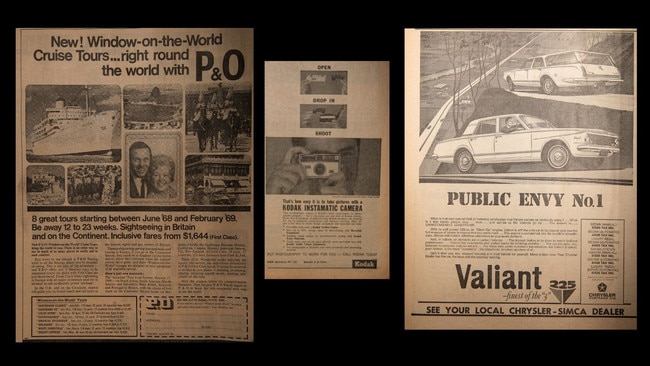
May 28, 1968
While most immigrants arrived in Australia by sea, the idea of the pleasure cruise, at affordable prices, took flight, as it were, with Australian Women’s Weekly tours in the mid-60s. In fact, P&O claimed the first cruise offer on Strathaird, a mail steamer, from Sydney, calling at Brisbane and Norfolk Island in 1932. By the late 60s, aboard Arcadia, the world was your oyster.
July 17, 1964
How did we record our precious memories? In photographs, but ones taken far more judiciously in the pre-digital age, given the high cost of developing film. Many people may remember fondly their first Box Brownie camera, but from 1963 the Kodak Instamatic, with its easy-to-load drop-in film cartridge, revolutionised the hobby. An Instamatic 100, made in Coburg, Melbourne, sold for $17.30.
July 15, 1964
For many families in the 1960s, holidays were at the same destination (in rental flats or camping grounds), year in, year out. And we travelled by car – station wagon if possible and with radio, otherwise entertainment was sibling squabbles in the back seat. There were three market giants (which often stirred lifelong family loyalties), General Motors-Holden, Ford Australia and Chrysler (an ill-fated Leyland P76 appeared in 1973). Chrysler trotted out local assemblies of American autos until the Valiant AP5 in 1963, styled and manufactured here. The Slant-Six engine of the 225 model was the height of auto aspiration.

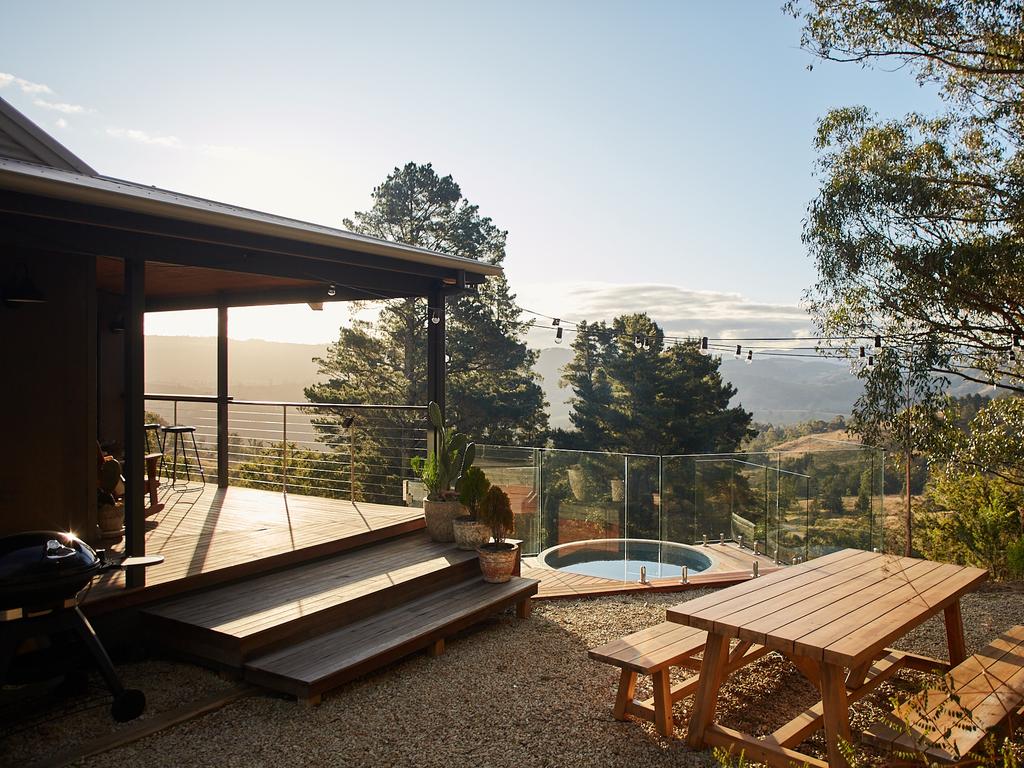
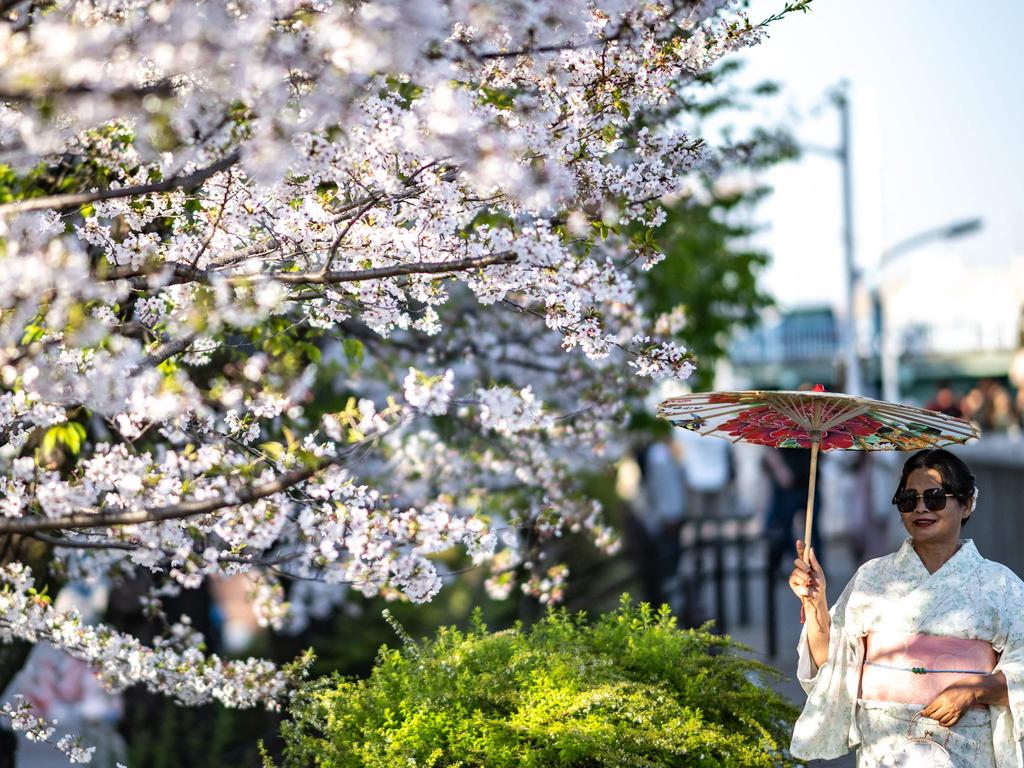
To join the conversation, please log in. Don't have an account? Register
Join the conversation, you are commenting as Logout